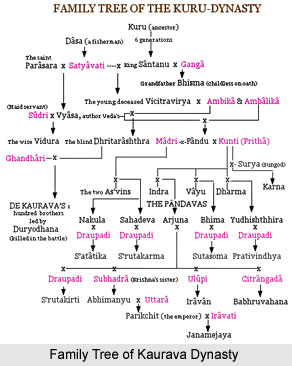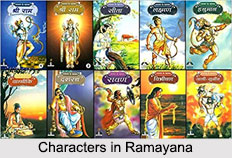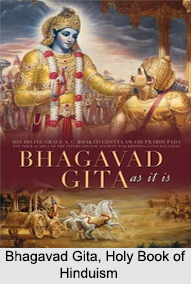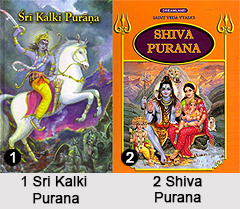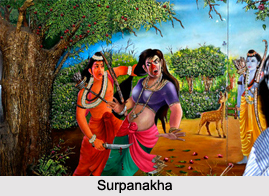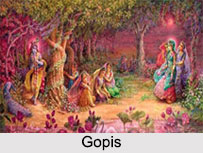 Gopika or Gopi is referred to the cow herding girls famous within Vaishnava Theology for their unconditional devotion (bhakti) to Lord Krishna. An important aspect of Lord Krishna`s childhood was his dance with the Gopis called the "raslila", which eventually became the object of worship by many of the devotional sects.
Gopika or Gopi is referred to the cow herding girls famous within Vaishnava Theology for their unconditional devotion (bhakti) to Lord Krishna. An important aspect of Lord Krishna`s childhood was his dance with the Gopis called the "raslila", which eventually became the object of worship by many of the devotional sects.
Etymology of Gopis
Gopi in Sanskrit stands for `cow-herd girl` in Hinduism and other Puranic literature. It is a word of Sanskrit originating from the word "Gopala" referring to a person in charge of a group of cows.
Myths of Gopis
In Vedic society, unmarried girls from 10 to 14 years of age were believed to worship either Lord Shiva or the goddess Durga in order to get a nice spouse. In Vrindavan, the unmarried girls were believed to worship Lord Krishna. All the unmarried Gopis in Vrindavan were used to worship daily goddess Katyayani early in the morning after taking bath in the river Yamuna. Katyayani is another name for goddess Durga. They worshiped goddess Durga entirely for one month in order to get Krishna as their husband by praying. They prayed for Krishna to become their husband, and being a lord Krishna tried to fulfil their wishes.
Gopis used to go to the bank of the Yamuna to take bath. They would come together, holding each other`s hands, and loudly sing to please Krishna. At the time of "raslila", Krishna multiplied himself into many Krishna look alike. This amazing experience made the Gopis strongly believe that Krishna was lord himself. Gopis were used to assist Radha and Krishna in Vrindavan. They were used to make happy Radha and Krishna by singing, dancing and playing instrumental music. It illustrates the intense love that Gopis had for Krishna was a form of devotion to god and through this the devotee was performing Bhakti, a form of religious practice advocated in the Bhagvad Gita.
Division of Gopis
The Gopis of Vrindavan are total 108 in number; "Krishna Charit" describes the number as 16,000. They are generally divided into three groups and these are as follows:
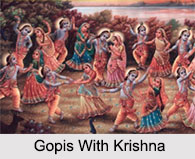
•Gopi friends of the same age as Krishna
•Maidservants
•Gopi messengers
Of the three kinds of Gopis, Krishna`s contemporary Gopi friends were are the most dignified. The second group, maidservants were the next most dignified and the messengers come following them.
Characteristics of Gopis
Radharani was a well-known Gopi and is held with high reverence and importance in a number of religious traditions, especially within Gaudiya Vaishnavism. The primary eight Gopis were considered as the foremost of Krishna`s devotees after Radharani. These Gopis were Lalita Sakhi,Visakha Sakhi ,Campakalata Sakhi ,Citra Sakhi ,Tungavidya Sakhi, Indulekha Sakhi and Rangadevi Sakhi Sudevi Sakhi .
Lalita devi Gopi was the leader and controller of all the praised young Gopis. Her complexion was like yellow colour and her garments were like peacock feathers. Lalita devi was full of ecstatic love for the Divine Couple. The principal Gopis in Lalita`s group were Ratnarekha (Ratnaprabha), Ratikala, Subhadra, Candrarekhika (Bhadrarekhika), Sumukhi, Dhanistha, Kalahamsi and Kalapini.
Visaka was the second most of the eight Gopis. Visakha`s garments are decorated with stars and her complexion is like lightning, being cream-colored with a tinge of red (gaurangi). Visaka was the intimate friend of the Divine couple and takes up the work of carrying messages between Radha and Krishna. The principal Gopis in Visaka"s group were Malati, Madhavi, Candrarekha, Subhanana, Kunjari, Harini, Surabhi and Capala.
Campaklata was the third of the gopis .The colour of her complexion was of a blossoming yellow champak flower hence her name was Campaklata. Campaklata handled the duties of collecting fruits, flowers and roots from the forest .At the same time she was also an expert cook particularly for various candy for which she become famous by the name "Mistahasta" (sweet hands). The chief Gopis in Campakalata`s group were Kurangaksi, Suracita, Mandali, Manimandana, Candika, Candralatika, Kandukaksi and Sumandira.
Citra, another Gopis had a beautiful saffron complexion and her garments were the colour of crystal. Citra used to read the books and letters written in many different languages, and used to sense the hidden intentions of the author. She was a skilled gourmet and could understand the tastes of various foods made with honey, milk, and other ingredients simply by glancing at them. She could nicely make various kinds of beverages. She was also well versed in the theoretical and practical activities of protecting domestic animals and an expert in gardening. The chief Gopis in Citra`s group were Rasalika, Tilakini, Saurasen, Sugandhika, Vamani, Vamanayana, Nagari and Nagavallika.
Tungavidya was the fifth of the Gopis. Her complexion was the colour of "kunkuma" and the fragrance of her body was like sandalwood. The chief Gopis in Tungavidya`s group were Manjumedha, Sumadhura, Sumadhya, Madhureksana, Tanu madhya, Madhusyanda, Gunacuda and Varangada. She was an expert music teacher who plays the vina and sings in the style known as "marga" .The Gopis in Tungavidya`s group were the best dancers. These Gopis are especially engaged in fetching water from the streams in Vrindavan.
Indulekha was the sixth of the Gopis. She had a lemon-yellow (tan) complexion and used to wear garments of the colour of a pomegranate flower. She had a deep love for Krishna and used to bring delicious meals for him. She was the expert at making wonderful necklaces, gemmology and weaving various kinds of clothes. She carried the auspicious messages of the Divine couple and was aware of their confidential secrets. Some of her friends were engaged in providing ornaments for the Divine Couple, others provide exquisite garments, and others guard their treasury. The Gopis in Indulekha`s group were Tungabhadra, Citralekha, Surangi, Rangavatika, Mangala, Suvicitrangi, Modini and Madana.
Rangadevi was another Gopi whose complexion is the colour of lotus filament and her garments are red like a jaba flower. Her qualities were very similar to those of Campaklata. She was very fond of joking with her friend Radharani in the presence of Lord Krishna. The chief Gopis in Rangadevi`s group were Kalakanthi, Sasikala, Kamala, Prema Manjari, Madhavi, Madhura, Kamalata and Kandarpa-sundari. Kalakanti was the leader of the eight friends of Rangadevi.
Sudevi was the eighth of the principal Gopis and the sister of Rangadevi. She has a similar complexion like that of Rangadevi .She was a dear friend of Radharani and arranged her hair, massages her body and decorates her eyes. The principal Gopis in Sri Sudevi`s group were Carukavari, Sukesi, Manjukesika, Harahira, Harakanthi, Haravalli and Manohara. Sudevi`s friends were the deities of Vrindavan forest and they were charged with the protection of the forest birds and bees.
The beautiful Gopis can be considered in hundreds of groups, each group containing hundreds of thousands of Gopis. In Hindu Vaishnava theology, the stories concerning the Gopis are said to exemplify Suddha-bhakti which is described as `the highest form of absolute love for God` (Krishna). Their firm devotion is described in depth in the later chapters of the Bhagavata Purana, within Krishna`s Vrindavan pastimes and also in the stories of the sage Uddhava.













